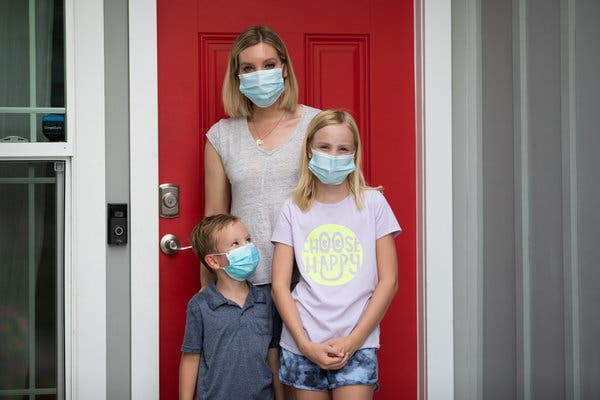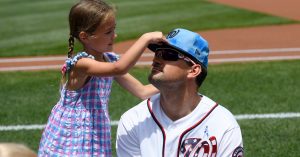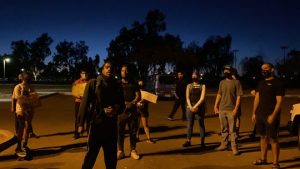Lately, Sophia Gholz has started to feel like her family is the odd one out.
In Jacksonville, Fla., where she lives with her husband and two children, mask-wearing is a rarity, she said. For weeks she’s driven by beaches and restaurants packed with people. Kids are gathering in the playgrounds and skate parks just like before the pandemic.
It was tough to see everyone having fun together, she said, while her family continued to wear masks and physically distance, avoiding socialization. Soon the self-doubt began. She started asking herself, “Am I damaging my children? Am I making the wrong choice?”
“I think it’s a constant game of mental checks and balances,” said Gholz, 39, an author of children’s books. “And then you look at the news at the end of the day and you see the numbers and you think, ‘OK, well, at least we’re not in the hospital.’”
As states reopen and coronavirus cases surge throughout much of the United States, families are facing a patchwork of differing and sometimes contradictory rules surrounding social distancing, making it difficult to assess the risks associated with different activities. Playgrounds are starting to open in some states, and young children are being asked to stay six feet apart and wear masks, an often unrealistic expectation.
At day care centers, the Centers for Disease Control and Prevention recommend that the children sit and nap at least six feet apart from one another, but the agency also says group play is permissible when dividing the children into smaller, staggered groups. Some states are reinstating youth sports while others have instituted a temporary ban.
Social distancing restrictions have also become politicized and divisive. According to a Kaiser Family Foundation poll conducted in May, more than three times as many Republicans as Democrats say their state is opening “too slowly,” and Democrats are almost twice as likely as Republicans to say they wear a mask when they leave their house. The Pew Research Center has found partisan differences as well: Public confidence in medical scientists has increased among Democrats, but not Republicans, a poll showed.
It’s understandable that sometimes people feel confused, especially given that the medical community has often been at odds with political leaders, said Mark Sawyer, M.D., a pediatric infectious disease specialist at Rady Children’s Hospital-San Diego and a professor at the University of California, San Diego.
“We are basically carrying out a grand experiment right now by gradually letting things relax,” he said.
For some families, it’s a constant exhausting mental calculus. Is it counterproductive for little kids to wear masks? Should we visit this playground? What’s the best way to form a “quarantine pod” with another family? Is Little League truly safe this year?
“There are so many conflicting things coming out of everyone’s mouth that I don’t know what to believe,” said Gary Hubbard, 39, a father of two in Orlando who is unemployed. “All the information is so fluid.”
His wife, Alana Hubbard, agreed, citing the confusing directives about masks and her own uncertainty about how the C.D.C. is collecting and tallying coronavirus cases and deaths.
“I do believe that Covid is real and people are dying, but I don’t believe it’s as bad as the media has made it out to be,” Alana Hubbard, a photographer and travel agent, said.
So when Florida reopened in May, the Hubbard family decided to seek pre-pandemic normalcy. They headed to the pool, the beach and later to Orlando’s Universal Citywalk, an outdoor dining and entertainment venue, for their daughter’s birthday. Since then they’ve also hosted grandparents in their home, and their children, ages 7 and 9, play freely with other kids in the neighborhood.
“We don’t have any huge, really bad, underlying health problems, so we think we’ll be all right,” Gary Hubbard said.
His wife, 33, is a cancer survivor with asthma and an autoimmune condition that makes it difficult for her body to regulate its temperature, but both she and her husband felt it was more beneficial to do social activities with their kids than stay isolated indoors. After learning that only a small percentage of children with Covid-19 have become severely ill, they have prioritized their mental health and need for physical activity as well as their desire to help stimulate the economy.
Much like the Hubbard family, Candice Novak, 41, a lawyer who lives in Omaha, was initially socially distancing but then, as the state reopened, she and her family started relaxing their rules. Novak was glad to see one of her son’s favorite activities return: baseball.
“I guess my only reservation is getting used to the new normal,” she said. The children can’t share helmets, give high-fives or eat snacks after the game, she said. The bleachers are also off limits.
“Do I still have fear? Yes. I think we all do,” Novak said. “But I think the desire to get back to normal outweighs the fears right now.”
Janica Duncan, 38, an elementary school substitute teacher who lives in Monmouth, Ore., near Salem, is in a state where youth contact sports have not been allowed to resume. She worries that the social distancing regulations that affect children are being made without taking into consideration the potential mental or emotional effects.
“I have had my 4-year-old cry to me, saying, ‘No one wants me to play at their house,’ thinking that she did something wrong that she couldn’t play with other kids,” Duncan said. “I have a 15-year-old son who asks me every day whether or not I think he will be able to play football in the fall, since Oregon has banned all sports and activities for children and youth that could spread the virus. He is trying to hard to stay positive, but I know it is a struggle.”
Duncan, who has five children ranging in age from 4 to 16, understands the importance of being cautious. Her family initially formed a quarantine pod with her sister’s family and then gradually started socializing with others. Duncan tells her children to wear masks in stores to be respectful of others, especially older adults.
“My teenagers say, ‘Why do we have to when nobody else is?’” she said. “I try to explain to them, I’m not worried about you getting sick, that’s not why we’re wearing it.”
Because the medical community doesn’t know how common it is for asymptomatic children to transmit the virus to others, it is difficult for states, cities, businesses, schools and other places to implement policies for children.
Meg Fisher, M.D., a pediatric infectious disease specialist and the medical director of the Unterberg Children’s Hospital at Monmouth Medical Center in Long Branch, N.J., said personal risks don’t change just because the city or world is opening up, and how careful you need to be should be influenced by who lives in your household, whether they are high-risk and whom you come in contact with on a regular basis.
Physically distancing is still important, she added, because the virus is spread via respiratory droplets when people talk, shout, sneeze or cough. “What you are trying to avoid is being face-to-face with an unmasked or poorly masked person for several minutes,” she said.
Diana Camacho, 35, a health care administrator in Oakland, Calif., and the mother of a 1-year-old, initially was worried about sending her daughter to day care during the pandemic because she knew it would be impossible for the children to socially distance. But she and her husband were struggling to work from home without child care, waking up at 5 a.m. to work in the morning and staying up late, too. It quickly became unsustainable, so when their day care reopened in June, they sent her back.
“Honestly, the first week or so was a lot of stress and anxiety over whether I made the right decision,” she said. Many of Camacho’s peers had enlisted the help of relatives. For Camacho and her husband, that was not an option. But she felt reassured when she saw the kinds of precautions their day care was taking and how much happier her daughter seems now.
The most difficult decision was figuring out how to safely let her daughter see both pairs of grandparents, two of whom have health problems. When Camacho visits them, she brings everything they plan to use, including utensils and chairs, and tries to enforce physical distancing.
“I feel like I’m a director of play and I’m trying to keep all the moving pieces,” Camacho said. “Ultimately I think it was worth it for my daughter, but it’s exhausting actually doing it and making decisions. In some ways it’s just easier to stay home and do nothing.”



















